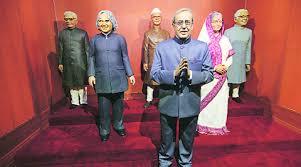Visit to Rashtrapati Bhawan Museum
In a follow-up to the International Adolescent Summit, students of class XI namely, Ritwika Dasgupta, Rishabh Bhatia and Kshitij Srivastava were taken for a visit to the Rashtrapati Bhawan Museum on 16 December, 2016. The accompanying teacher was Ms. Enakshi Rai. This initiative was taken by Expressions India which is a school-based outreach programme for the promotion of Life Skills, Values Education, School Health and Well being.
The Rashtrapati Bhawan Museum has two buildings facing each other. While the old building has only one floor, the new building consists of three floors, each distinct in its own way. The three floors are connected to each other by hi-technology elevators and escalators.
Situated at the entrance to the old building are wax statues of presidents who have held office since independence and are a key attraction of the museum. To the end of the gallery is an enclosure fitted with electronic touch- screens and speakers playing patriotic songs.
The new building, on the other hand, is known for its collection of artefacts, vehicles and statues of ancient India. Among the vintage vehicles, the items which caught the attention of the students were the Victorian coach, the Mercedes Benz S06 SEL and the Vintage luggage coach used around 100 years ago! There were various virtual photo-displays for visitors to the museum as well.
[gallery link="file"]
This building has a beautiful miniature model of the Rashtrapati Bhavan on display along with the personal belongings of many former presidents, including, Dr. A.P.J Abdul Kalam, R. Venkataraman and mementos presented to them while in office.
This museum is divided into enclaves. The first has a copy of the first sketch of the Rashtrapati Bhawan while the second exhibits water colour drawings of Edwin Landseer depicting India before democracy!
The museum also displays, the Constitution of India. Infact, one can listen to the recorded version a reading of it. The new building is equipped with two audio-visual theatres playing videos of the Beating the Retreat ceremony and the freedom struggle. There are also statues showcasing the Swadeshi Movement, Gandhiji's Salt March, the Jallianwala Bagh massacre and the Charter Act (1853).
A section of the museum is dedicated to a display of badges awarded to officers of the defence forces. Another striking feature of the museum is a counter showcasing a collection of stamps and coins. It includes the Rs 75 and Rs 100 coins that were released to commemorate the Commonwealth Games.
The visit was an extremely enriching and noteworthy experience. The only disappointing aspect of the visit was that one could not capture what one had seen inside, as photography is prohibited there.
Ritiwika Dasgupta, XI D













